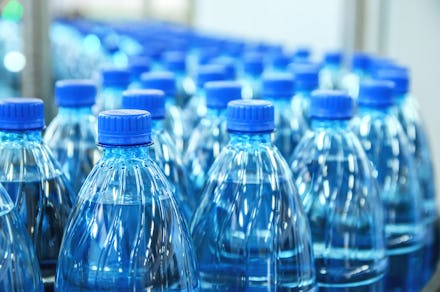By now we’ve all learned about the disastrous impact of plastic microbeads making their way from your face scrub and body wash and into the ocean. However, those beads are the tip of the iceberg when it comes to the microscopic plastics floating around that aren't visible to the naked eye. And if you frequently grab a plastic water bottle to hydrate, that could be a problem, as microplastics in bottled water may be coming at higher levels than you thought.
Most of us don’t think twice about what’s in our bottled water (though the plastic bottles themselves are another story), assuming that it’s always safe to drink. That’s generally true, however a new study from the MRC-PHE Centre for Environment and Health, Analytical and Environmental Sciences at Kings College London found that if you drink bottled water regularly you could be consuming around 90,000 microplastic particles per year, and that's on top of what most people already consume without realizing it.
We already ingest thousands of plastic particles via the air we breathe and the food we eat as microscopic bits of plastic are virtually everywhere in our environment now. Some of this comes from plastic production, but a lot of the plastic we consume actually makes its way into our food during the packaging process. Depending on your age and sex, you can consume 74,000 and 121,000 particles annually. Drinking water from plastic bottles can add the additional 90,000 due to the packaging and bottling process.
If you drink water from the tap, the study says you can cut down that 90,000 figure to between 3,000 and 6,000, again depending on your age and sex. Everyone's body is different, and how we absorb compounds on a daily basis has a lot to do with your body type.
While the exact impact on human health isn’t fully known, there is evidence that microplastics can be absorbed into human tissues where they, “can trigger an immune reaction, or release toxic substances and pollutants absorbed from the environment, including heavy metals,” according to a CNN report.
Despite the Kings College report’s findings, scientists say more research needs to be done to more accurately determine the level of microplastics the average human is consuming because the additional amount of exponentially smaller nanoplastics that we consume is largely unknown.
"Particle size is only mentioned in passing ... and yet this has a massive effect on the data presented and the conclusions reached," Professor Richard Lampitt, leader of the microplastic research team at the National Oceanography Centre in the United Kingdom, told Science Media Centre. “Many of the studies on which the study's database is built will have failed to detect very small particles that some consider to be ‘nanoplastics and outside of this present study’."
Unfortunately, the overall effects of micro and nanoplastics on our bodies hasn’t been conclusively determined. But, to be safe, and help out the environment while you’re at it, carrying your own water bottle might be a good way to go. The majority of plastic water bottles aren’t recycled, and they will take aeons to decompose, often ending up polluting the ocean and other natural environments as they degrade.
In addition to water bottles, there are a whole range of other single-use plastics that end up in the garbage every day and contribute to this problem. If you’re interested in learning more about how you can reduce the amount of plastic in your life (and ultimately in your body), check out our guide here.
